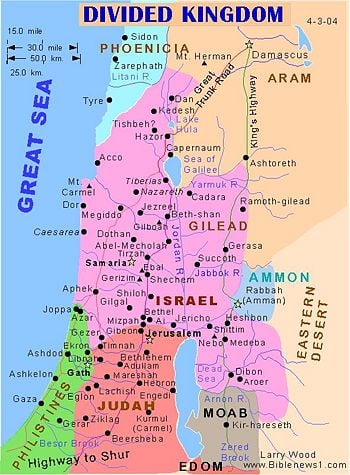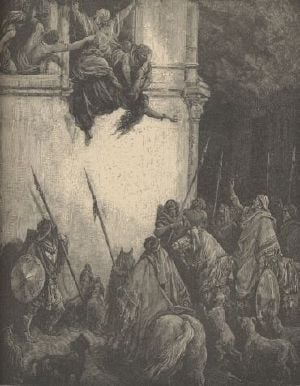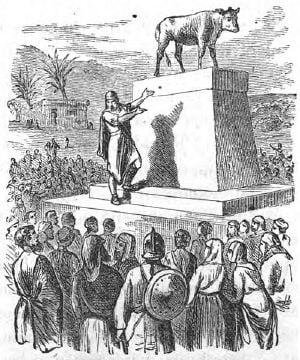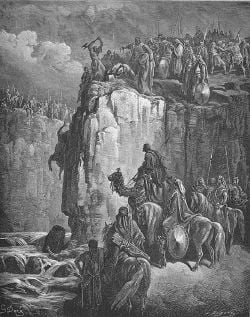Kingdom of Israel
The Kingdom of Israel (Hebrew: מַלְכוּת יִשְׂרָאֵל, Standard Hebrew Malkut Yisrael) was the kingdom proclaimed by the Israelite nation around 1030 B.C.E. - 1020 B.C.E., enduring until it fell to the Assyrian empire in 722 B.C.E.. Traditionally, the nation of Israel formed as the Israelites left Egypt during the Exodus and conquered Canaan under Joshua's leadership. An alternative theory based on recent archaeological evidence suggests a more gradual evolution of a national identity as semi-nomadic Hebrew-Canaanite clans affiliated and became the nation of Israel.
In the biblical account, the Hebrew people, were led by the Patriarchs and later by Judges prior to the establishment of the kingdom. The notion of kingship was for a long time resisted, viewed as putting a man a position of reverence and power reserved for God. The people appealed to the prophet-judge Samuel for a king, after Samuel's sons misused their inherited offices. The United Kingdom of Saul, David, and Solomon endured for a period of 120 biblical years and then split into two nations. This article will focus on the Northern Kingdom, or Israel. For information on the Southern Kingdom, please consult the article on the Kingdom of Judah.
Jerusalem was the capital of the United Kingdom. The first capital of Northern Kingdom was Shechem (1 Kings 12:25), then Tirza (14:17), and finally Samaria (16:24), which endured until the destruction of the kingdom by the Assyrians (17:5).
There are no contemporary extra-biblical references to the leaders of the United Kingdom. Contemporary scholars are supscious of the biblical story's historical accuracy, seeing it as an glorified account with numerous exaggerations and anachronisms. Our primary sources for the history of the Northern Kingdom are the biblical books of Samuel, Chronicles, and especially Kings, together with occasional historical references in the prophets and other biblical books. These are histories with a religious agenda and are not accepted uncritically by historians. However, beginning with Jeroboam I, several neighboring rulers left records that confirm some of the historical details of the biblical chronicle, while of course differing in political slant and religious outlook.
The area of the Northern Kingdom of Israel fluctuated greatly, and scholars disagree as to it actual borders at any given time. Neighboring peoples such as the Judahites, Amonites, Moabites, Aramean-Syrians, and Phonecians often lived within Israel's "borders" and vice versa. The Northern Kingdom is thought to have encompassed as many as 9,400 square miles, and as few as 2,400 or less. A similar problem arises with regard to population. The biblical numbers regarding the size of cities and armies are generally much larger than those suggested by the archaeological evidence.
'United' Monarchy
Around 1030-1020 B.C.E., Saul became the first king of Israel. A natural leader of uncommonly tall physical stature, he gained important military victories against Israel's traditional enemies, the Philistines and Amalekites. The degree to which he unified the tribes under a single Israelite authority is uncertain. According to the Book of Samuel, he ruled with God's approval for only two years, due to his disobedience in failing to complete the slaughter of the Amalekites.
Thereafter he continued to reign while the young and future king David gained fame among the southern tribes as a bandit leader of heroic proportions. After Saul's death in battle with the Philistines, David was anointed king by the tribe of Judah at Herbron, where he remained for seven years. The northern tribes of Ephraim and Benjamin made Saul's son Ish-Bosheth their king in the town of Mahanaim, probably near the Jabbock River. During this time David captured the strategic Jebusite town of Jerusalem and made it his capital. A civil war between David's forces and the northern tribes supporting Ish-Bosheth raged intermittently, ending as the northern military commander, Abner, switched sides and assassins soon closed in on Ish-Bosheth.
After this, David consolidated the monarchical government in Jerusalem. He embarked on successful military campaigns against Israel's enemies, creating more secure borders. However, he faced several rebellions, in which elements of the northern tribes joined.
The Bible describes the next king, Shlomo, or Solomon, as a leader of great wisdom who expanded the United Kingdom into a great empire and constructed a glorious national Temple in Jerusalem. His reign is portrayed as a time of unprecedented peace, power, and prosperity for Israel. However, the historicity of this claim has come under challenge by recent scholarship and archeology, which consider it impossible that so vast and rich an empire as is described in the Bible could have existed given the small population base that in reality existed in Solomon's day. Because we have only the highly pro-Solomonic biblical account to inform us, we do not know what extent the northern tribes retained independence or resisted Solomon's rule.
The Northern Kingdom
The history of the Northern Kingdom will be divided into four segments. The first begins with the rebellion of Jeroboam and ends with the ascension of the Omrian dynasty. The second begins with Omri and ends with the coup by Jehu. The third begins with Jehu and ends with Menahem. The fourth traces the decline of the Kingdom of Israel until its fall during the Assyrian invasion of 722 B.C.E.. (See chart, below.)
Jeroboam to Omri
Despite the biblical portrayal of a vast united empire under King Solomon, Jerusalem's control of the territory of Israel outside of Judah was minimal except for some amount of taxation and forced labor. There is little to suggest that inhabitants of the territory known as "Israel" had acted together previously except in opposition to the house of David. The harsh labor policy of Solomon's son, Rehoboam, gave the northern tribes a strong reason to coalesce under the leadership of Jeroboam I. Jeroboam united the northern tribes and created or expanded two major religious shrines, one in the northern district of Dan, the other just a few miles north of Jerusalem at Bethel. His erection of these sites, designed to create national cohesion and provide convenient access for pilgrims, earned him the enduring enmity of the Jerusalem priesthood and the biblical authors.
Israel was initially at a disadvantage against Judah due a lack of a standing army and also because of internal strife. The rule of Jeroboam's tribe, Ephraim, became unpopular; and his son Nadab (913) was slain by the usurper Baasha, of the tribe Issachar (911). Meanwhile the northern districts suffered from border attacks from the Arameans of Damascus.
Baasha moved the capital from Schechem to Tirzah and made a treaty with Damascus. This, together with the advantage of a greater population and better natural resources than landlocked Judah, enabled him to strengthen Israel's position. However, when King Asa of Judah influenced the Arameans to break with Baasha, Israel lost fertile lands northwest of the Sea of Galilee as well as militarily significant southern high ground. Baasha's son Elah (888) was slain in a military coup led by the cavalry commander Zimri. Zimri's reign was short-lived, however, and of the two leaders who competed to succeed him, the military general Omri soon emerged victorious.
Omri to Jehu
Omri established a powerful dynasty and made Israel into a major regional power. He built an impressive new capital, the strategically located town of Samaria in central Palestine, increasing his control of overland trade and providing good access to the Mediterranean. He ended the fratricidal war with Judah and established a friendship with the Phoenician power of Tyre, sealed by a marriage between his son Ahab and the Tyrian princess Jezebel. Omri also consolidated Israel politically and resisted both Damascus to the north and the Moabites to the south.
Ahab (875) built on his father's foundation economically and politically. He defended Israel against the threat from Damascus and eventually forged an alliance with Judah and Damascus against the growing Assyrian power of Shalmaneser II. Despite his friendship with Jerusalem, Ahab's marriage to Jezebel and his reported willingness to honor the Phoenician deity Baal brought religious strife with Yahwist elements centering on the powerful itinerant prophets Elijah and Elisha, whose opposition eventually proved fatal to the promise of the Omrian dynasty. When war with Damascus broke out again, and Ahab died battle at Ramoth-Gilead.
Ahab's son Ahaziah died soon after his accession and succeeded by his brother Joram (853). He vigorously prosecuted the war with Damascus, but internal opposition by internal religious forces grew stronger. The prophet Elisha went so far as to anoint the Syrian leader Hazael to punish Israel's alleged idolatry and instigated a coup de etat against Joram by a military leader, Jehu. Joram and his mother, Jezebel, were soon put to death together with their entire extended family, and a widespread slaughter of the priests of the Baal followed. Jehu also killed Joram's southern ally, King Ahaziah of Judah, ironically paving the way for Jezebel's daughter Athaliah, to seize the throne in Jerusalem.
Jehu to Menahem
Soon after seizing power, Jehu found himself in trouble with than Elisha's other recently anointed king, Hazael of Damascus. Jehu appealed to Shalmaneser III of Assyria, an act memorialized in the Black Obeslisk unearthed in northern Iraq.
When Assyrian campaigns against Damascus waned, however, Hazael prevailed against both Israel and Judah. Under Jehu's son Jehoahaz, Israel was reduced to a vassal state of Damascus. After the death of Hazael, Assyria moved against Damascus again. This enabled Jehoahaz' son Joash (also called Jehoash to distinguish him from the Judean king of the same name) to defeat Damascus' new king, Ben-hadad III, in battle and recapture lost territory. He also struck against Judah, where he reportedly sacked Jerusalem and looted its Temple (2 Kings 14).
Israel reached the zenith of its power after the ascension of Jeroboam II (c. 783), who recaptured substantial Syrian and transjordanian territories and made Israel an even greater power than it had been in the days of the Omrian dynasty. However, this external glory was short-lived. Affluence gave rise to moral corruption, which was eloquently decried in the oracles of the literary prophets Amos and Hosea. Jeroboam's son Zachariah was assassinated by Shallum, beginning a period of instability and decline. Shallum was soon put him to death by an army officer, Menahem.
Menahem to Hoshea
Israel could no longer avoid the Assyrians. Menahem's main recorded contribution was to stave off invasion by paying a tribute of thousand talents of silver to Tiglathpileser III. His son, Pekahiah, ruled only briefly. His assassin, Pekah, took the throne around 735 B.C.E., just in time to face the return of the Assyrians. Pekah allied with Damascus against both Assyria and Judah. Against Judah he had some success, but the Assyrians succeeded in annexing the Galilee. Israel's territory was now little more than the district surrounding the capital of Samaria. Pekah was assassinated by Hoshea.
The last king of Israel, Hoshea remained an Assyrian vassal until around 724 when the resurgence of Egypt's counterbalancing power led him to believe that revolt against Assyria could succeed. In this belief, he was tragically mistaken. The capital fell to an Assyrian siege in 722. Some 27,000 of its inhabitants were reportedly deported, and the district of Samaria became an Assyrian province. The deportees were scattered throughout the East. Today, they are popularly known as the Lost ten tribes of Israel. The Assyrians brought various eastern peoples to colonize lands vacated by the deportees. These and later arrivals at times intermarried with the remaining Israelites to form the mixed-blood people later known as Samaritans.
Religious Dimension
The author of the Book of Kings presents the history of the Northern Kingdom primarily as a manifestation of the struggle between the One-God principle and idolatry. Political fortunes rise and fall according to whether various kings do "what is right" in the Lord's eyes or not.
Those who honor Yahweh, Israel's God, do well. But this alone is not enough. They must also avoid any hint of worshiping other deities, and must aggressively move to destroy Canaanite religions other than Yahwism. Just as important, they must not continue the "sin of [the first] Jeroboam," namely to support the Israelite shrines at Bethel and Dan with their golden calf statues.
In this scenario, none of Israel's kings does the right thing. The House of Jehu, brought to power on the foundation of the ministry of the prophets Elijah and Elisha, receives praise for destroying Baal worship. However because even the kings of this pro-Yahwist dynasty allow the worship of the Canaanite goddess Ashera and refuse to pull down the bull calf statues at Dan and Bethel, they too are judged as evil in God's sight. God provides a final chance for repentance during the days of Jeroboam II through the prophecies of Amos and Hosea. Amos emphasizes the need for a religion based on moral principles and social justice, while Hosea calls on Israel to abandon her "adulterous" worship of other gods and to return to Yahweh, her true and loving husband. When Israel refuses to change her ways, the prophetic doom pronounced by these oracles comes to pass in the form of the final Assyrian victory over Israel in 722 B.C.E..
Critical view
Critics point out that this biblical history of the Northern Kingdom was written by Judean priests, men who were loyal to Jerusalem and for whom the Yahweh-only principle was paramount. One might see an analogy in a history of the American Civil war written by an adamant northern abolitionist.
The biblical writers see the hand of God in such events as Jehu's brutal murder of Ahab's family and the mass slaughter of the prophet-priests of Baal by Elijah and later again by Jehu. These authors tolerate no compromise with religious pluralism. Even the ancient shrine at Bethel (the "house of El") is, to them, an abomination. Critical scholars wonder if the bull calf statue was the real issue, or whether it was more likely one of control. After all, the bible has no objection to the golden statues of the cherubim that occupied a place of honor in the Temple of Jerusalem. In declaring "Here are your 'gods' (Elohim), O Israel" was Jeroboam I truly denying Yahweh/Elohim, or was he merely declaring that the God of Israel (Elohim) could be worshiped just as well at Dan and Bethel as in Jerusalem? Critics also argue that the biblical account represses feminine depictions of the Divine, portraying God as masculine and furiously warlike, while denouncing feminine symbols of God as idolatrous. Archaeologists point out that until its demise, the Northern Kingdom was far more prosperous, populous, and advanced than the Southern Kingdom in terms of architecture and other aspects of culture; yet the bible portrays Jerusalem the only Hebrew city of glory and denigrates the cosmopolitan successes of North as manifestations of idolatry.
Whether or not one accepts the spiritual veracity of the biblical version of providential history, it can hardly be denied that this account favors Judah over Israel, and that it presents the viewpoint of the Jerusalem priesthood at the expense of the monarchs and religious institutions of the Northern Kingdom.
The Kings of Israel
For this period, most historians follow either of the older chronologies established by William F. Albright or Edwin R. Thiele, or the newer chronology of Gershon Galil, all of which are shown below.
| Albright dates | Thiele dates | Galil dates | Common name | Regnal Name and style | Notes |
|---|---|---|---|---|---|
The House of Saul | |||||
| c.1021 B.C.E.–1000 B.C.E. | c.1030 B.C.E.–1010 B.C.E. | Saul | שאול בן-קיש מלך ישראל Shaul ben Qysh, Melek Ysr’al |
Benjaminite tribesman. Fought Amalekites and Philistines. Killed in battle. | |
| c.1000 B.C.E. | c.1010 B.C.E.–1008 B.C.E. | Ishbaal (Ish-bosheth) |
איש-בשת בן-שאול מלך ישראל Ish-bosheth ben Shaul, Melek Ysr’al |
Led Benjamin and n. tribes in civil war against David. Assassinated after betryal by his general, Abner. | |
The House of David | |||||
| c.1000 B.C.E.–960s B.C.E. | c.1008 B.C.E.–970 B.C.E. | David | דוד בן-ישי מלך ישראל David ben Yeshy, Melekh Ysr’al |
Son-in-law of Saul and legendary rebel leader. Established monarchy with Jerusalem as its capital. | |
| c.960s B.C.E.–c.922 B.C.E. | c.970 B.C.E.–931 B.C.E. | Solomon | שלמה בן-דוד מלך ישראל Shelomoh ben David, Melekh Yisr’al |
Son of David by Bathsheba. Described as reigning in peace over a United Kingdom. | |
| Israel was divided into northern (Israel) and southern (Judah) kingdoms | |||||
The House of Jeroboam | |||||
| 922 B.C.E.–901 B.C.E. | 931 B.C.E.–910 B.C.E. | 931 B.C.E.–909 B.C.E. | Jeroboam I | ירבעם בן-נבט מלך ישראל Yerobo’am ben Nebat, Melek Ysr’al |
Broke from Judah in labor dispute. Established national shrines in Dan and Beth-El. |
| 901 B.C.E.–900 B.C.E. | 910 B.C.E.–909 B.C.E. | 909 B.C.E.–908 B.C.E. | Nadab | נדב בן-ירבעם מלך ישראל Nadab ben Yerobo’am, Melek Ysr’al |
Laid siege to Philistine city of Gath, where he was assassinated by Baasha. |
The House of Baasha | |||||
| 900 B.C.E.–877 B.C.E. | 909 B.C.E.–886 B.C.E. | 908 B.C.E.–885 B.C.E. | Baasha | בעשא בן-אחיה מלך ישראל Ba’asa ben Achiy’a, Melek Ysr’al |
Moved capital to Tirzah in Issachar. Lost territory when Damascus allied with Judah. |
| 877 B.C.E.–876 B.C.E. | 886 B.C.E.–885 B.C.E. | 885 B.C.E.–884 B.C.E. | Elah | אלה בן-בעשא מלך ישראל ’Alah ben Ba’asa, Melek Ysr’al |
Reigned two years and was assassinated by Zimri. |
The House of Zimri | |||||
| 876 B.C.E. | 885 B.C.E. | 884 B.C.E. | Zimri | זמרי מלך ישראל Zimry, Melek Ysr’al |
Ruled for 7 days. Kingdom splits briefly but unites under the military leader Omri. |
The House of Omri | |||||
| 876 B.C.E.–869 B.C.E. | 885 B.C.E.–874 B.C.E. | 884 B.C.E.–873 B.C.E. | Omri | עמרי מלך ישראל ’Omry, Melek Ysr’al |
Consolidated the nation, built new capital at Samaria, made peace with Judah and Tyre. |
| 869 B.C.E.–850 B.C.E. | 874 B.C.E.–853 B.C.E. | 873 B.C.E.–852 B.C.E. | Ahab | אחאב בן-עמרי מלך ישראל Achwav ben ’Omry, Melek Ysr’al |
Developed Israel's economy and military, but faced internal religious strife. Killed in battle. |
| 850 B.C.E.–849 B.C.E. | 853 B.C.E.–852 B.C.E. | 852 B.C.E.–851 B.C.E. | Ahaziah | אחזיהו בן-אחאב מלך ישראל ’Achazyhu ben ’Ach’ab, Melek Ysr’al |
Died soon after coming to power. Not to be confused with Judean king of the same name. |
| 849 B.C.E.–842 B.C.E. | 852 B.C.E.–841 B.C.E. | 851 B.C.E.–842 B.C.E. | Joram | יורם בן-אחאב מלך ישראל Yoram ben ’Ach’ab, Melek Ysr’al |
Assassinated with his mother Jezebel by Jehu at the instigation of the prophet Elisha. |
The House of Jehu | |||||
| 842 B.C.E.–815 B.C.E. | 841 B.C.E.–814 B.C.E. | 842 B.C.E.–815 B.C.E. | Jehu | יהוא בן-נמשי מלך ישראל Yehu’a ben Nimshi, Melek Ysr’al |
Carried out a ruthless purge of Baalism. Offered tribute to Assyria. Warred unsuccessfully with Damascus. |
| 815 B.C.E.–801 B.C.E. | 814 B.C.E.–798 B.C.E. | 819 B.C.E.–804 B.C.E. | Jehoahaz | יהואחז בן-יהוא מלך ישראל Yeho’achaz ben Yehu’a, Melek Ysr’al |
Submitted to Assyria. A Yahwist but condemned by the Bible for supporting the shrines at Dan and Bethel. |
| 801 B.C.E.–786 B.C.E. | 798 B.C.E.–782 B.C.E. | 805 B.C.E.–790 B.C.E. | Jehoash (Joash) |
יואש בן-יואחז מלך ישראל Yeho’ash ben Yeho’achaz, Melek Ysr’al |
Recaptured lands taken by Hazael of Damascus. Paid tribute to Adad-nirari III of Assyria. |
| 786 B.C.E.–746 B.C.E. | 782 B.C.E.–753 B.C.E. | 790 B.C.E.–750 B.C.E. | Jeroboam II | ירבעם בן-יואש מלך ישראל Yerobo’am ben Yeho’ash, Melek Ysr’al |
Brought Israel to the height of its power externally. Moral corruption of his kingdom was condemned by Amos and Hosea. |
| 746 B.C.E. | 753 B.C.E. | 750 B.C.E.–749 B.C.E. | Zachariah | זכריה בן-ירבעם מלך ישראל Zachariah ben Yerobo’am, Melek Ysr’al |
Assassinated by Shallum. |
The House of Jabesh | |||||
| 745 B.C.E. | 752 B.C.E. | 749 B.C.E. | Shallum | שלם בן-יבש מלך ישראל Shallum ben Yabesh, Melek Ysr’al |
Assassinated by Manahem. |
The Last Houses of Israel | |||||
| 745 B.C.E.–738 B.C.E. | 752 B.C.E.–742 B.C.E. | 749 B.C.E.–738 B.C.E. | Menahem | מנחם בן-גדי מלך ישראל Menochem ben Gady, Melek Ysr’al |
Staved off Assyrians by paying tribute. |
| 738 B.C.E.–737 B.C.E. | 742 B.C.E.–740 B.C.E. | 738 B.C.E.–736 B.C.E. | Pekahiah | פקחיה בן-מנחם מלך ישראל Pekahyah ben Menahem, Melek Ysr’al |
Assassinated by Pekah |
| 737 B.C.E.–732 B.C.E. | 740 B.C.E.–732 B.C.E. | 736 B.C.E.–732 B.C.E. | Pekah | פקח בן-רמליהו מלך ישראל Pekah ben Ramalyhu, Melek Ysr’al |
Assassinated by Hoshea. |
| 732 B.C.E.–722 B.C.E. | 732 B.C.E.–722 B.C.E. | 732 B.C.E.–722 B.C.E. | Hoshea | הושע בן-אלה מלך ישראל Hosh’e ben ’Alah, Melek Ysr’al |
A vassal of Assyria, but rebelled. Assyria conquered Samaria, exiled thousands and colonized the territory. |
ReferencesISBN links support NWE through referral fees
- Abright, William F. The Archeology of Palestine, Magnolia, MA: Peter Smith Pub Inc; 2nd edition, 1985 ISBN 0844600032
- Bright, John. A History of Israel, Louisville KY: Westminster John Knox Press; 4th edition, 2000 ISBN 0664220681
- Keller, Werner. The Bible as History, NY: Bantam, 1983 ISBN 0553279432
- Galil, Gershon. The Chronology of the Kings of Israel and Judah, Leiden: Brill Academic Publishers, 1996 ISBN 9004106111
- Grant, Michael. The History of Ancient Israel, NY: Charles Srcibner's Sons, 1984, ISBN 0684180812
- Miller, J. Maxwell. A History of Ancient Israel and Judah, Louisville KY: Westminster John Knox Press, 1986 ISBN 066421262X
- Thiele, Edwin R. The Mysterious Numbers of the Hebrew Kings, Grand Rapids, MI: Kregel Academic & Professional; Reprint edition, 1994 ISBN 082543825X
External links
All links retrieved March 3, 2025.
- Kingdom of Israel Jewish Encyclopedia
- Complete Bible Genealogy A synchronized chart of the kings of Israel and Judah
Credits
New World Encyclopedia writers and editors rewrote and completed the Wikipedia article in accordance with New World Encyclopedia standards. This article abides by terms of the Creative Commons CC-by-sa 3.0 License (CC-by-sa), which may be used and disseminated with proper attribution. Credit is due under the terms of this license that can reference both the New World Encyclopedia contributors and the selfless volunteer contributors of the Wikimedia Foundation. To cite this article click here for a list of acceptable citing formats.The history of earlier contributions by wikipedians is accessible to researchers here:
The history of this article since it was imported to New World Encyclopedia:
Note: Some restrictions may apply to use of individual images which are separately licensed.




